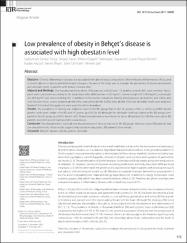Low prevalence of obesity in Behçet's disease is associated with high obestatin level

Göster/
Tarih
2017Yazar
Koca, Süleyman SerdarKara, Murat
Özgen, Metin
Dayanan, Ramazan
Demir, Caner Feyzi
Aksoy, Kader
Işık, Ahmet
Üst veri
Tüm öğe kaydını gösterÖzet
Objective: Chronic inflammatory diseases are associated with altered body composition. Ghrelin has anti-inflammatory effects, and its level is altered in obesity and inflammatory diseases. The aim of the study was to evaluate the prevalence of obesity and ghrelin and obestatin levels in patients with Behç et's disease (BD). Material and Methods: One hundred and forty-three (143) patients with BD and 112 healthy controls (HC) were enrolled. Participants were subdivided according to the body mass index (BMI) as lean (< 18.5 kg/m2), normal weight (18.5-24.9 kg/m2), overweight (25-29.9 kg/m2) and obese (> =30 kg/m2). In addition to the routine evaluations (fasting blood glucose, lipid profile, and kidney and liver function tests), serum acylated-ghrelin (AG), unacylated-ghrelin (UAG), total ghrelin (TG) and obestatin levels were analyzed. Student's t-test and chi-square test were used for statistical analysis. Results: The prevalence of obesity was relatively lower in the BD group than in the HC group (12.6% vs. 20.5%, p=0.089). Serum ghrelin levels were similar in the BD and HC groups (p> 0.05 for all) although the obestatin level was higher in the BD group compared to the HC group (p< 0.001). Serum UAG, TG and obestatin levels were lower in obese BD patients (n=18) than non-obese BD patients (p=0.027, p=0.014 and p=0.001, respectively). Conclusion: The obestatin level was high and the prevalence of obesity was low in the BD group. Moreover, obese BD patients had low obestatin levels. These results suggest that obestatin may protect BD patients from obesity.
Kaynak
European Journal of RheumatologyCilt
4Sayı
2Bağlantı
https://app.trdizin.gov.tr//makale/TWpJek1qQTRPQT09https://hdl.handle.net/20.500.12809/8677

















